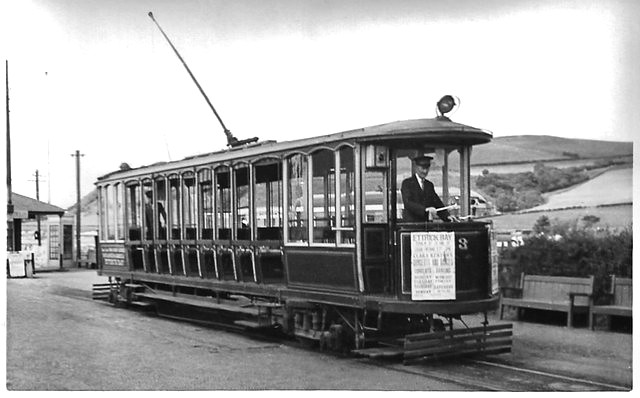#British Electric Traction
Video
Rothesay tram No. 3 at Ettrick Bay by Frederick McLean
Via Flickr:
An old photograph of Rothesay and Ettrick Bay Light Railway car No. 3 at Ettrick Bay on the Isle of Bute, Scotland. The photo reverse is stamped as it having been taken by (and/or the original neg is owned by) C. Carter. No. 3 was built in 1902 by the Electric Railway and Tramway Carriage Works Ltd. seating 32+18 (32 on its crossbench seats and 9 in each of the two end saloons) and running on Brill 22E reversed maximum traction bogies. From 1901 (electrified in 1902) until 1914 the tramway was owned by British Electric Traction, and from 1914 until the tramway closure in Sep 1936 it was controlled by the Scottish General Transport Co. who from 1932 had a name change to the Western Scottish Motor Traction Co. 📷 Any photograph I post on Flickr is an original in my possession, nothing is ever copied/downloaded from another location. 📷 ------------------------------------------------- If there are any errors in the above description please let me know. Thanks. Any photograph, ephemera, etc I post on Flickr is in my possession, nothing is copied from another location. The original photographer may have taken copies from their original negative and passed them out (sold them?) so there may be other copies out there of your (and my) 'original' transport photo, although occasionally there may be 'holiday snaps' type photos where there are not any other photos exactly the same in existence. If you wish to use this image (bearing in mind it may not be my copyright) or obtain a full size version (most of my uploads are small size) please contact me.
#British Electric Traction#Rothesay and Ettrick Bay Light Railway#Rothesay tramway#Scottish General Transport Company#Western Scottish Motor Traction Co#Isle of Bute#Ettrick Bay tram#Rothesay tram#old photograph#old transport#old tramway#old tram#old tramcar#vintage transport#vintage tram#vintage photograph#vintage tramway#vintage tramcar#transport photograph#tramway#tram#tramcar#transport#Electric Railway & Tramway Carriage Works#Brill 22E#Scottish tramway#C. Carter#public transport#strabenbahn#streetcar
12 notes
·
View notes
Text
GE PowerHaul

After I offered, @valtionrautatiet-official asked me to post some pictures of the locomotive that is nowadays known as the Dr20, used by the private freight operator North Rail in Finland. Here it is in 2012, long before anyone ever even considered sending it to Finland, in Berlin. The reason that it's in Berlin specifically is that it's at Innotrans, the biggest trade fair and exhibition for railroads that exists. At this point it had the paint job of HHPI (Heavy Haul Power International, despite the important sounding name really just one of many European freight rail companies with headquarters in Germany), with their trademark blue and red and their company policy of putting Newton's second law on it. "Project Power" also sounds cool, doesn't it? Well, it turns out they never entered service for HHPI. Way too much history under the cut.
The story behind these eight locomotives is weird and opaque, and there is a lot of stuff we may never know, but on a very fundamental level it seems to be one of the victims of what I call the six-axle diesel curse. This basic of that theory of mine is that it's impossible to sell big, heavy, powerful diesel locomotives, the kind that are so powerful that they need six axles for all the weight from their big engine and diesel tank, in (West) Germany and to a certain extent central and Western Europe, at least nowadays, unless you do it by accident.
The German locomotive industry has wanted to build big six-axle diesel locomotives since the end of steam traction. There was a prototype six-axle version of the V 200, named V 300, in the 1950s, but DB didn't want it (a related but less powerful version was sold to Yugoslavia to haul Tito's private train). For the Americans here, the Krauss-Maffei locomotives of the Southern Pacific and Rio Grande were related to that.
A few years later, in 1962, we get the V 320, a six-axle version of the V 160 locomotive family. The four-axle version was very popular and is still in service, but they only built the prototype of the six-axle version. Interestingly, that one prototype is still around as well, hauling construction trains. Deutsche Bahn was never interested, they preferred the flexibility of having more smaller units. And anyway, they were busy electrifying the busy main lines that would have made the most use of those heavy machines.
In the 1970s Henschel and BBC (the electric equipment one, not the British TV one) built three copies of the DE 2500 both with four and six axles, but those were really more experimental machines.
In the late 1980s and early 1990s, MaK tried to sell their DE 1024, and I actually have a picture of that ne.
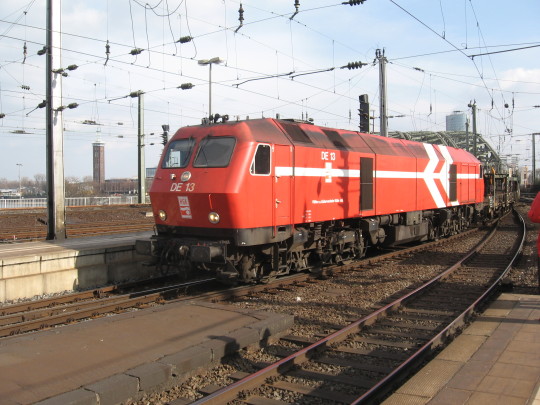
They built three prototypes, and Deutsche Bahn seemed to genuinely toy with the idea… but in the end it was decided to electrify the lines in the (mostly flat) north that hadn't been electrified yet anyway.
And at the same time, the wall fell, and suddenly Germany had access to all the locomotives of the east, now mostly surplus since mostly the industry they served did not survive the transition to western markets. East Germany had bought powerful six-axle diesel locomotives in enormous numbers from the Soviet Union, specifically modern-day Ukraine, and those were available, good enough and already paid for. In particular the class 232 and related, known as "Ludmilla" among rail fans, have proven very useful.
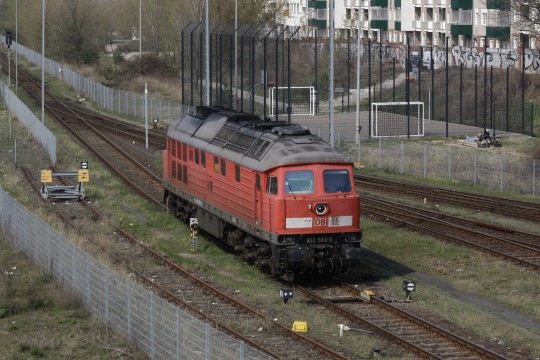
MaK was able to sell an altered version of that locomotive to Norway, but that turned out to be be a huge disaster as they developed a habit of catching on fire. Eventually Siemens (who briefly owned MaK) had to take them back, and since then they've changed hands an astonishing number of times - apparently right now Hector Rail and RDC Autozug have a lot of them. Here's one in Hamburg Altona when it was used on regional trains there.

The three prototypes went to locally owned operator HGK, where two of them also burned down. DB probably dodged a bullet there. Interestingly enough, the only one that didn't burn down was number 13, but that was finally scrapped a few years ago.
In the mid-1990s, ADtranz (later Bombardier) and GE got together to build the Blue Tiger locomotive, a very distinctive-looking and noisy machine. They sold 11 to various private operators in Germany, 30 to Pakistan and 20 to Malaysia. Not terrible, but not a huge success either.
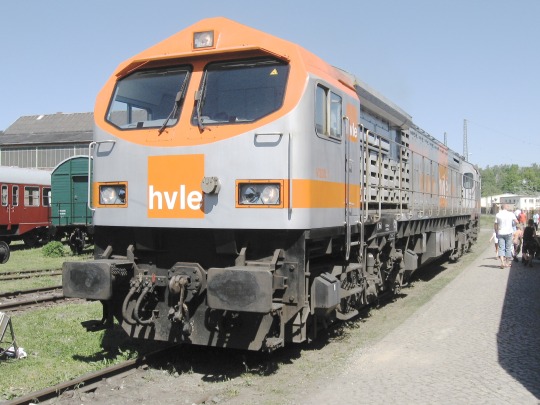
But in the 2000s, things were changing. Liberalisation meant that more and more companies were running services all throughout Europe. The busy main lines were electrified, but many of the border crossings weren't yet, so there was a new need for big six-axle diesel locomotives.
The big beneficiary of this was EMD from North America, who were already supplying such locomotives to Great Britain. The rail companies there needed these machines to replace unreliable British-built power, and to replace environmentally friendly electric locomotives, because most of the British network is not electrified and the few sections that are have way too much traffic on them.
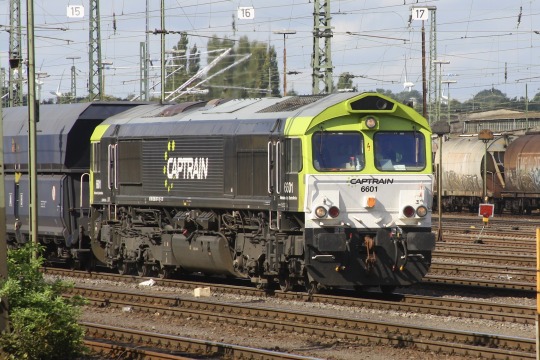
The Class 66 is an ugly mess, designed by figuratively building a metal shed in the inside of a tiny British rail tunnel. It's so noisy that drivers in Norway get hazard pay for being in them. But it works and it was mass produced, and a lot of them made their way to the continent in short order.
Other companies wanted in on that business. Voith decided to enter locomotive building after previously supplying traction equipment. They had high hopes for their Maxima series of locomotives, which they started building in 2008, and they had their own leasing company. They did a lot of marketing and the machine won prestigious design awards.
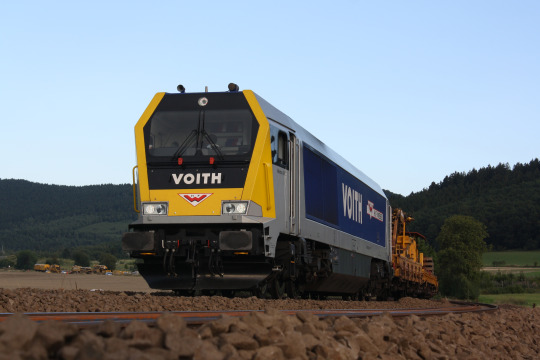
At one point they had a hundred pre-orders. In the end their own leasing company folded, and they only built twenty, which they didn't even manage to sell that quickly. Nowadays they've stopped producing locomotives again.
General Electric, the other North American locomotive company, wanted in on that action as well. Sure, it hadn't worked with the Blue Tiger, but years had passed and things were different now. For their new product, the PowerHaul, they decided to follow what EMD had done. They started with the class 77 for the British market, first shown at Innotrans in 2010.

Then they wanted to work their way out to wider Europe, with a special continental version that was designed with a bigger shell to match the larger tunnels on the continent. That way they weren't quite as cramped. EMD had considered a similar idea, a European-sized class 66, but decided against that.
GE also did not intend to make them themselves. Instead after the initial batch of British 77s, they transferred production to their Turkish partner Tülomsaş, who supplied some more British ones and the ones for central Europe. 29008 is one of them.
In the end all of these plans fell through. A lot of the international border crossings did get electrified much quicker than the diesel sellers had hoped. The one near where I live, the Montzenroute, started electric running in December of 2008, and it was actually the makers of electric locomotives who made bank off of the new international railway world. Here is a Bombardier TRAXX electric locomotive during the first week that freight trains from Germany to Belgium were running with electric power, just a few hundred meters from the border.
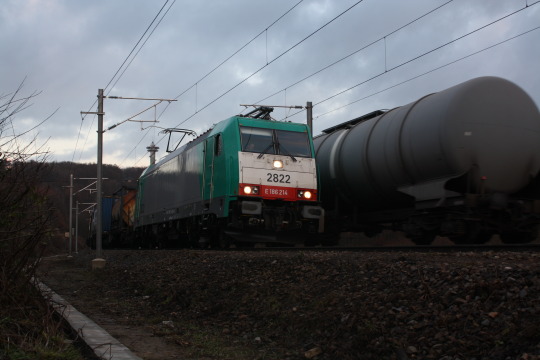
But the business changing is one thing, the story of the PowerHauls seems to be even more complicated. After all, GE did have a launch customer for their PowerHaul, in the form of HHPI. The locomotives were built, painted in HHPI colors, and tested. And then… well, nothing. They never entered service, instead sitting for years in Cottbus, Germany. I have no idea whether they ever got approved for service in Germany. Finnish Wikipedia says "HHPI had no use for them", but that sounds like a euphemism. Clearly HHPI had some use for powerful locomotives, they've recently taken delivery of some Stadler EuroDuals.
The EuroDual and the closely related Euro9000, pictured below, seem to be the solution to the six axle diesel curse though the conceptually simple but technologically difficult trick of simultaneously being a very powerful electric locomotive as well. They have already delivered more of them than Voith Maxima, GE Blue Tiger and GE PowerHaul combined. Sorry for the pictures, they don't park the locomotives well for good photos at Innotrans.
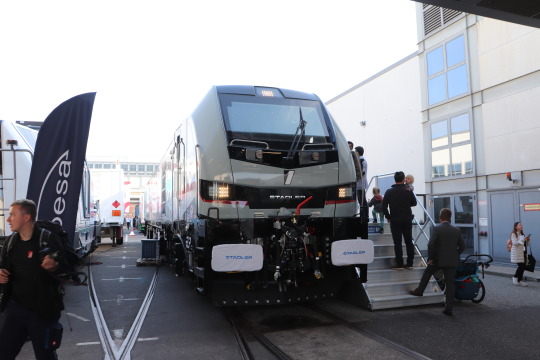
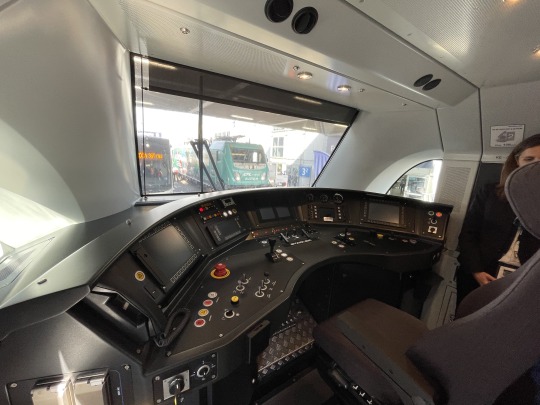
Also, GE was not able to find any customer in Germany, nor in Sweden, where some units of that type were tested at some point. Locomotives of that type were built for Turkey, though, and I haven't heard anything negative about them there. Those were also at Innotrans, in 2014.
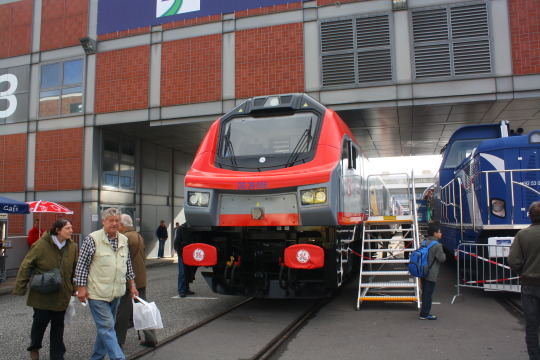
And then, years after everyone had forgotten about these machines, they suddenly turned up in Finland, in the hands of North Rail (formerly Operail), one of the few private companies there. That required at least new couplings, new axles (Finland has a different rail gauge, the measurement of how far the rails are apart), probably adjustments to the breaks, new train control systems and so on.
It's possible that North Rail was thoroughly convinced by the advantages of GE's concept or something, but I think it's far more likely that they just got a really good deal because GE was happy someone took them off their hands.
The reason they're in Finland is almost certainly that Operail needed some cheap machines that weren't doing anything, and these units were just that. But why were they not doing anything? Why were these machines doomed to sit in Cottbus for years, essentially still in new condition, painted for an operator that didn't want them? I'm sure you'll find plenty of theories if you look on online forums, and it's even possible that one of them is the truth, but unless some rail journalist decides to really dig into that, we'll probably never know for certain.
If you allow me to speculate: It certainly doesn't sound like a success story, and there have been all sorts of other stories where trains didn't get approval to run in the country they were ordered for, or had severe technical defects. Ask an Austrian rail fan about the Talent 3, a danish about the IC 4 or a dutch or Belgian about the Fyra to get some really fun rants. I don't know if these locomotives belong in that hall of shame, but it would certainly be an explanation.
My guess is that there won't be any more of these machines ever. GE Transportation doesn't even exist anymore, the whole part of the business got sold to Wabtec a few years ago. But if these machines are doing well in Finland now, good for them! Finally someone found something to do with these weird-looking units.
16 notes
·
View notes
Text
My amazing friend @chelledoggo has graciously made me my very own “Figmentsona”!
I call him Wanbi (pronounced “one-bee”)! Read more about him under the cut!
(yes, i will colour this in later)

In a time before time was a concept, before electricity or even paper, there was The Dreaming. Aboriginal Australians believed that the creatures and beings from the Dreaming, or Dreamtime, were what shaped the earth they lived on, and provided its resources, natural gifts and even states of mind. Even after the British colonisation of Australia, Dreamtime stories such as those of the Rainbow Serpent and Tiddalik the Frog were passed down through word of mouth by the Aboriginal people, later gaining traction through written word and more modern forms of communication. However, among the many well-known ones in modern Australian society, one is more obscure. The tale of Wanbi (pronounced “one-bee”), a hybrid of a waruga (a water dragon) and a warrigal (dingo), with the wings of a banguu (bat), and floppy, buru (kangaroo)-like ears. Just as the aforementioned Rainbow Serpent gave the earth life, Wanbi gave the earth the gift of imagination, and became the guardian spirit of the Eora and Dharawal nations (what is now commonly known as Sydney and its surrounding areas). An optimistic, kindhearted and happy creature, the spirit of Wanbi has guided the indigenous people of Australia through challenges and troubles, with the power of both his and their imaginations providing the people with ideas and enriching their culture. In recent years, Wanbi has become close friends with Figment, and his creator Blairion “Blair” Mercurial, the Dreamfinder, sharing tales of their many experiences across history, and with Wanbi enlightening both Blair and Figment to tales of imagination that both had never heard of before.
#figment#disney#journey into imagination#epcot#chelle art#figmentsona#wanbi#dreamtime#aboriginal#creature
18 notes
·
View notes
Note
so the Japanese maglev is in prototype stages but what are the current fastest trains? I heard there's a super slick maglev in Shanghai
The Shanghai Maglev is an incredible machine and is currently the fastest train service in commercial operation, with a cruise speed of 268 mph. Its job is to move passengers from the airport to Longyang Road Station, from where they can transfer to other non-maglev lines to get to the city center. The Shanghai Maglev was designed as a test, sort of a proof of concept. The idea was to show this was viable and could be used to do a maglev rail network across the country.
Now I should point out that 268 mph is the cruise speed, which means that's just the fastest it operates with passengers. During testing...it went faster.
The top operational commercial speed of this train is 431 km/h (268 mph), making it the world's fastest train in regular commercial service since its opening in April 2004. During a non-commercial test run on 12 November 2003, piloted by Jonathan Texiera, a maglev train achieved a Chinese record speed of 501 km/h (311 mph).
Now if we're talking about current fastest trains all across the board...
Steam: everyone who follows me likely knows this by now, but the current speed record holder for steam traction is LNER 4468 Mallard, an A4 4-6-2 Pacific designed by Sir Nigel Gresley. Here is a link to my post on Mallard from earlier this year if you want to read more about that. I don't shut up about this locomotive ever. Mallard's record sits at 126 mph.
Electric, (Conventional) Steel-Wheeled: The TGV POS currently holds that record, with trainset 4402 setting it in April 2007 at a whopping 357.2 mph.
Diesel: A diesel-electric British Rail Class 43 set a diesel speed record in 1987 - locomotive 43102 (renumbered 43302), trailed by 43159, managed to hit 148.5 mph. There are reports a Spanish Talgo XXI hit 159 mph in 2002 and a Russian TEP80 hit 168 mph in 1993, but those haven't been verified. It's possible, though!
Electric, Maglev: As fast as that one in Shanghai is, the SCMaglev does have it beat. The L0 series currently sits atop the maglev high score boards with a manned test run that hit 375 mph in 2015.
Wikipedia does have a whole page on railway speed records if you want to learn more! I'd recommend checking it out.
9 notes
·
View notes
Text
Penguin Band + Cadence Gijinkas & Headcanons !!

Headcanons under the cut (:
Headcanons from left-to-right of drawing order.!!
Franky
19 Years old, the youngest member of the penguin band
He/Him, Trans Man
Bisexual
Afro-Canadian
The lead singer of the Penguin Band, and the most versed in instruments. Typically plays the keyboard when performing with the band, but can play the guitar, bass, flute and violin.
He likes to invent in his free time. Fixes the other band member’s instruments and Cadence’s turntables when they break.
Used to work at the Pet Shop, where he’d often sing to the Puffles when he found himself alone with them. This is where he met Petey K, who was the one to later invite him to join the band.
Like the book “Franky’s First Show” suggests, he joined the band at a later date, after it had already been founded.
Despite this, he’s the “most popular” member of the band, according to tabloids and teen-scream magazines.
Likes to wear warm clothing, and lots of layers.
While he seems very chill and calm, he still gets nervous before every show.
His favourite genres of music are Hip-Hop and Pop
Stompin’ Bob
20 Years old
He/Him, Cis Man
Bisexual
African-American
The bassist of the Penguin Band, but he also likes to rap!
He writes the songs for the band, finding his inspiration from a multitude of places. He sometimes helps Cadence write her songs too.
Tough, and loves to adventure around the island! From going camping in the woods, to beating penguins at the toboggan races, and even trying to learn Card-Jitzu, Stompin’ Bob loves to spend his time having fun.
He used to work at the lighthouse, as security before starting the band.
The first of the members to move to Penguin Island, and one of the three founding members of the Penguin Band.
Upbeat and rowdy personality!!
Loves to dress in fishnets, ripped shirts, and studded accessories. Never seen without wearing his favourite eyeliner.
His favourite genre of music is rock! But he’s not a genre snob, and enjoys writing a multitude of genres for the band, but has a fondness for writing pop-punk, as he thinks it suits Franky’s vocal style best.
Petey K
20 Years old
He/Him, Cis Man
Gay Man
White, British
Plays the Electric Guitar for the band, previously played the accordion!
Composes most of the songs for the band, and works alongside Stompin’ Bob when it comes to the early conception of the band’s music. Often works on music for Penguin Island’s parties, to earn extra income.
Used to work at the Pet Shop, alongside Franky. Quit after the band began to gain traction.
A bit of a “Hipster”, Petey K is very witty, and enjoys going to art shows to find inspiration for his music. Loves to go to the Coffee Shop and listen to the music of upcoming penguin artists.
Cannot see without his glasses.
A bit of a self-proclaimed funny man, Petey likes to make jokes and quips in interviews, and plays pranks on his band mates, to varying degrees of success.
Likes to thrift all of his clothes!
His favourite genres of music are Cool Jazz, Garage Rock, and R&B.
G Billy
21 Years old, the oldest member of the Penguin band
He/Him, Cis Man
Gay Man
White, American, from the south.
The G is for “George”.
Plays the drums for the band, but can also play the bongos, and the flute!
The band was his idea.
Strong believer in “good” luck and “bad”, he always wears his lucky bandana to shows and concerts.
Used to ride horses ! Has been kicked by a horse before in his past. He grew up on a farm!
A foodie and talented chef, he used to work at the pizza parlour !
Honest and loyal, but also friendly and playful.
He books the band’s gigs for them, and is the best with time management.
Hates to disappoint people, especially his fans.
Likes to dress in plaid, and leather boots.
His favourite music genre is country, which is why it’s no surprise that his original vision for the band was for them to be a country one.
DJ Cadence
18 Years Old
She/They, Non-Binary
Bisexual
African-American
A DJ, singer, rapper and composer!
The younger sister of DJ Maxx (from Penguin Chat 3).
Her family owns the Night Club, where she hosts the Dance-Offs, and got her start in sharing her music!
A total scene girl, she loves to listen to loud music, make kandi bracelets, and attend raves.
Bad at controlling the volume of her voice, often is yelling without realising it.
Brings her pet Puffle, Lolz, with her everywhere.
Dislikes when her hair grows too long, as it causes her discomfort. Loves to dye her hair !!
Eyes are naturally brown, she wears contacts.
Loves to dance, releases detailed dance tutorials for all of her songs for her fans to follow along to and learn.
Is never seen without her scarf, no matter how badly it clashes with her outfits.
Dresses like she’s about to go to a party ! Loves bright colours, clashing patterns, and statement accessories.
Her favourite music genres are rock, indie, hip-hop, eurodance, and J-Pop !
#thunderstomm#tomm talks#okay to reblog#please reblog#art#my art#thunderstomm art#club penguin#the penguin band#penguin band#headcanons#Franky#franky club penguin#stompin bob#stompin bob club penguin#Petey k#Petey k club penguin#g Billy#g billy club penguin#dj cadence#dj cadence club penguin#feel free to ask me about more hcs btw !! I love sharing these !!#I might do more characters in the future no promises though !!#these doodles are very lazy so I’m sorry for that#cowards stop giving Franky hair give him a buzzcut or make him bald !!#mean comments will be deleted and you will be blocked if you leave them#(:#dj Maxx
6 notes
·
View notes
Photo

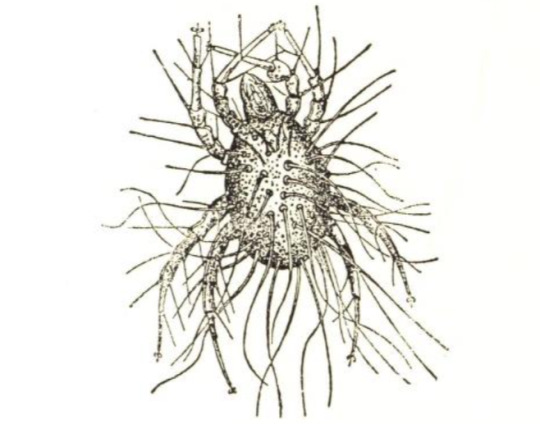
The Acarus electricus, or man-made insects [19th century hoax]
In 1836, a British scientist named Andrew Crosse had created life from nothing. He had succeeding in building strange mites in his laboratory by means of electricity and weird crystal formations – or rather, that is what the newspapers at the time claimed.
In reality, he did nothing of the sort, and was actually conducting an experiment to see if silica crystal formations could be artificially formed by means of electrical currents. Tiny white spots appeared on the crystals instead, and over time they grew into small, hairy animals: insects had formed, seemingly out of nothing, from the electrical shocks (small note: mites are not actually insects, but were considered insects at the time and therefore described as such by Crosse).
Receiving the same results after multiple attempts, he could not explain the appearance of these animals, as the equipment was supposed to be sterile and the experiment was conducted in a closed, caustic environment. An amateur physicist attempted to redo the experiment and invariably ended up with mites – but only when he added electrical currents. Without the electricity, no mites showed up.
Crosse, however, was a man of science and never actually claimed that he had created the little arthropods himself. Instead, he assumed the animals originated from minuscule eggs that somehow got on his equipment.
Unfortunately for him, however, the rumours of a synthetic, man-made lifeform that was created in a laboratory quickly gained traction and spread throughout England. Local newspapers were quick to jump on the amazing story of a man-made species and the poor man was harassed and received many angry letters and threats from people who accused him of playing God and called him a blasphemer, a reviler of religion, a disturber of peace and an atheist.
Even today, Crosse’s controversial experiment remains a popular subject among fans of occult and esoteric stories, although the common opinion today is that his tools were (obviously) contaminated with mites. Mites of the Acari subclass are very tiny, after all, and could have forced their way into enclosures that were incorrectly thought to be hermetically sealed.
Source:
Gould, R. T., 1929, Oddities: a book of unexplained facts. You can read the 1966 revised edition here.
(image 1: illustration by Philip Baynes for “The Electric Vampire” by F. H. Power, a 1910 short story in The London Magazine. It was inspired by the Acarus electricus, but was written as fiction. You can find it here, for those who want to read it. )
(image 2: a drawing of the mites, dubbed Acarus electricus, from the 1849 work “lectures on electricity” by H. M. Noad, reproduced by Rupert Gould in 1929)
#Not sure how to tag this#kinda stretching the definition of 'mythical creature' here#occult#esoteric#creatures#fictional creatures
25 notes
·
View notes
Text
More Idle RWS Thoughts
While I’ve been bored at work this week I’ve been thinking about how certain things on IRL railways would work in that setting. I know the Awdrys want it to be “as true to real-life railway operation as possible” but like, having vehicles be sentient changes things.
These days many/most trains have one driver controlling multiple engines linked through wired or wireless electrical controls, and some diesels (especially in North America apparently) don’t have cabs at all. Do these locomotives have, like, a telepathic link with each other, or are they just all able to sense the operator’s control inputs at the same time? Is there a “class divide” among diesels similar to the tank engine / tender engine divide between A and B units? Apparently some B units are converted from A units: is having your cab removed used as a punishment?
What about cow-calf engines - i.e. sets of two technically separate locomotives coupled together where only one has a cab. Are they one entity, or two? I know there was a Fairlie Articulated steam engine on TTTE who was portrayed as having two separate personalities, but the rack railway engines are single individuals even tough they have two faces. I also found out about “slugs,” which are extra sets of traction motors and wheels that can be coupled onto a diesel-electric to give it extra strength at low speed, but don’t have their own powerplant and run off the electrical power of the main locomotive. I’m gonna go with these not being sentient? Kind of like how a tender isn’t portrayed as its own being.
Dumb Engineering Idea: Could a slug on a steam engine be practical? I know Triplex engines had an extra set of drivers under the tender, and that they were insanely strong but couldn’t generate enough steam to supply all those cylinders at more than a crawl, but I’m guessing shutting down the third set for high-speed running wasn’t practical because of the resistance of “backdriving” the cylinders and they couldn’t just be disconnected from the wheels like a booster. But could a higher-speed tank engine produce enough steam that it could be hooked up to a set of wheels and cylinders with no boiler of its own for extra tractive effort in low-speed shunting? Or a tender engine that could swap a tender with cylinders and a small coal/water capacity (due to being less bulky to improve visibility when reversing) with a normal tender?
Modern trains require a lot of safety automation technology like train stops, positive train control, dead man’s switches, etc. In a world of sentient vehicles how much of this would just be engines having the ability to stop a train on their own or even override their drivers’ control, and how much of it would interfere with an engine’s autonomy? I know in Mountain Engines Culdee’s automated brakes are described as being under his control and that he could put them on by himself.
So... about smoke deflectors. I know they’re needed to keep smoke from being caught in the turbulent wake behind the front of a non-streamlined engine’s smokebox, but the way they protrude in front of the smokebox is... well, the British call them “blinkers,” and it doesn’t seem like engines would like having their peripheral vision blocked by a metal plate, especially since a flesh and blood horse can still turn its head, the iron kind not so much. Is there some kind of duct or other system that could deflect enough air upward to lift the smoke at high speeds without protruding in front of the smokebox, or would the flat-ish face disturb the airflow too much for it to be pushed into any deflector that didn’t block lateral flow?
Alternately, what about deflectors that can slide or rotate forward only when they’re needed - at high speeds and in tunnels, kind of like an airplane’s flaps? It seems like a compressed air cylinder could probably actuate them, or an electric or reversible pneumatic motor running off steam from the turret manifold turning a jackscrew. Or if nothing else, plexiglass deflectors might be feasible by the 1940s although they’d probably not be cheap and need frequent replacement.
7 notes
·
View notes
Text
Exploring Emerging Applications: Bioethanol Market Dynamics

Bioethanol Market is gaining traction as a viable fuel alternative is driven by increasing consumer demand for sustainable fuels
The bioethanol market has been gaining significant traction in recent years. Bioethanol is a biofuel produced by fermenting the sugar components of plants such as corn, sugarcane, or soybeans. It is commonly blended with gasoline as biofuel in vehicles to reduce vehicular emissions. Bioethanol combustion produces fewer greenhouse gases than gasoline and offers improved engine performance. It has emerged as a viable alternative to conventional transportation fuels. The growing environmental concerns and need to curb carbon emissions are driving the demand for biofuels.
The Global bioethanol market is estimated to be valued at US$ 13.7 Billion in 2024 and is expected to exhibit a CAGR of 9.8% over the forecast period from 2024 to 2031.
Key Takeaways
Key players: Key players operating in the bioethanol market are CropEnergies, British Sugar, New Generation Biofuels Holdings, Inc., Vivergo Fuels Limited, Butalco GmbH, and Global Green SA.
CropEnergies is one of the leading producers and distributors of bioethanol in Europe. British Sugar is a major bioethanol producer in the UK. New Generation Biofuels Holdings, Inc. produces bioethanol from non-food biomass in the US. Vivergo Fuels Limited produces bioethanol from wheat in the UK. Butalco GmbH specializes in bioethanol production from agricultural byproducts in Germany.
Growing demand: Stringent fuel emission norms and government incentives promoting the use of biofuels are fueling the demand for bioethanol in the transportation sector. Consumer preference for green fuel alternatives is also propelling the market. Rapid urbanization and industrialization particularly in Asia Pacific are increasing energy demands which bioethanol is helping meet sustainably.
Global expansion: Key players are investing heavily in capacity expansion plans and new production facilities globally to capitalize on the growing demand. North America and Europe currently dominate the market but Asia Pacific is expected to surge in demand over the forecast period with China and India emerging as lucrative markets.
Porter's Analysis
Threat of new entrants: Low economies of scale required for production and distribution.
Bargaining power of buyers: High as bioethanol is commodity product and buyers have many alternatives.
Bargaining power of suppliers: Low as raw materials like corn, sugarcane are widely available from numerous local farmers.
Threat of new substitutes: Threat from other biofuels and electric vehicles.
Competitive rivalry: Intense as the market is fragmented with many global and regional players competing on cost and quality.
Geographical Regions
The Asia Pacific region is projected to be the fastest growing regional market during the forecast period. Countries such as China, India, and Thailand are actively promoting ethanol blending with gasoline to reduce dependence on fossil fuel imports and curb pollution levels. Thailand in particular aims to substitute 10% of gasoline consumption with ethanol by 2025 driving growth of the bioethanol market in the Asia Pacific region
0 notes
Text

"FEAR COAL FAMINE; TRACTION COMPANY TO RESORT TO OIL," Vancouver Sun. October 9, 1912. Page 3.
---
B. C. Electric Applies to City for Permission to Install Auxiliary Tanks on Main Street.
---
MATTER IS URGENT, SAYS REPRESENTATIVE
----
Trouble Over the Connection of the Burnaby Line at Commercial Drive
----
Bearing out the reports printed exclusively in The Sun as to the possibility of a coal shortage in Vancouver unless a settlement be soon effected with the striking coal miners on Vancouver Island, the British Columbia Electric yesterday took action that indicates a fear that there will be a coal famine within the next few weeks which will seriously cripple their service. To meet this condition they petitioned the board of works for leave to lay a temporary siding on Union street, on which they could place oil tanks to supply their bollers with a portion of the fuel they require.
In a letter to the board Chief Engineer Conway of the B. C. Electric pointed out that if there was shortage of coal it would be absolutely necessary that they have some other means of keeping their boilers going.
City Engineer Fellowes was in sympathy with the request of the company, but the members of the committee refused to allow unprotected oil tanks on the street.
Might Burn False Creek.
Ald. Baxter pointed out that if they should catch fire, the whole bed of False Creek would be in a blaze within a brief interval and half the property along the shore be destroyed.
A representative of the company who was present declared that the matter was urgent. The company wanted the tanks within the next week or fortnight, and could not wait to put in permanent tanks, as certain members of the committee proposed they should.
It was eventually decided that the company should be allowed to put in underground tanks, which would com- ply with the regulations of the Under- writers' association. The privilege is, however, only given for six months, and the tanks have to be so placed as not to interfere in any way with the traffic on the street.
B. C. E. Up Against It.
Apparently the B. C. Electric company is up against it in the matter of making connections between the Burnaby line and the city service at Commercial drive.
Three years ago council gave the company permission to make a temporary connection, and now the B. C. E. want it to be made permanent. In a letter to the board of works they stated that an order for the connection had been made by the railway commission, but as the railway commission's jurisdiction ceases at the end of the Burnaby line's private right-of-way, it was evident, and the board satisfied itself that there was and could be no order regarding the Commercial drive connection.
Some of the members of the committee wished to give the company peremptory notice to take their curve out, but better counsels prevailed and finally it was decided that the engineer be asked to write and ascertain just what the company proposes to do. The feeling of the committee is that the company should find some other means of connection with the city.
Street Is Impassable.
A deputation from Commercial drive asked the council to have the street made passable as soon as possible. They said that on their part of the street there were twenty-two stores vacated, simply because there was no access to them.
The city engineer placed the blame partly on the Bitulithic company. which has the contract for paving the street, and partly on the fact that material had to be found for other streets, where pavement had been begun first.
Several members of the deputation stated that the sidewalk facilities were even worse than the roadway. Many buildings have to be moved back, and in places there is not room for people to get into the shops. The matter will be taken up a once by the proper officials and all the relief possible given.
It will be two months, according to Chief Engineer Fellowes, before connection can be made between the sewerage system of Point Grey and that of Vancouver.
#vancouver#vancouver island#coal mining#coal miners#strike#coal shortage#heating coal#capitalism in canada#heating oil#municipal politics#infrastructure project#fuel tanks#road building#false creek
0 notes
Text
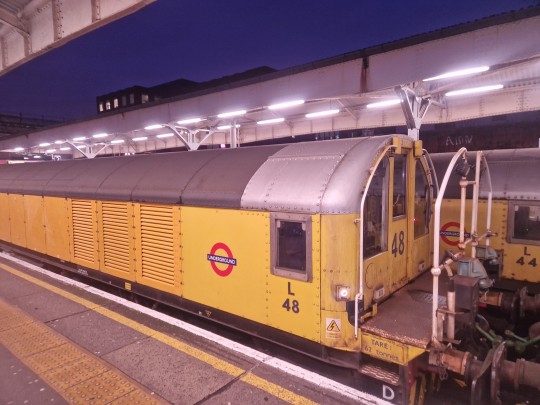
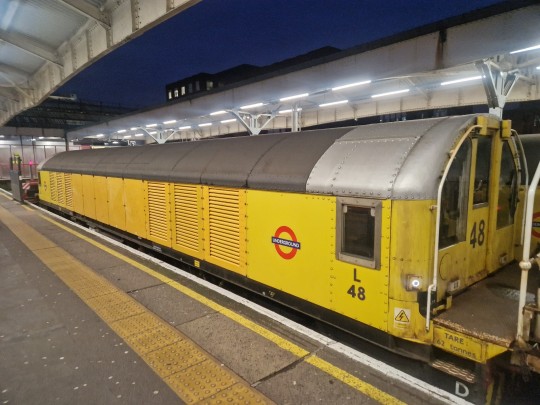
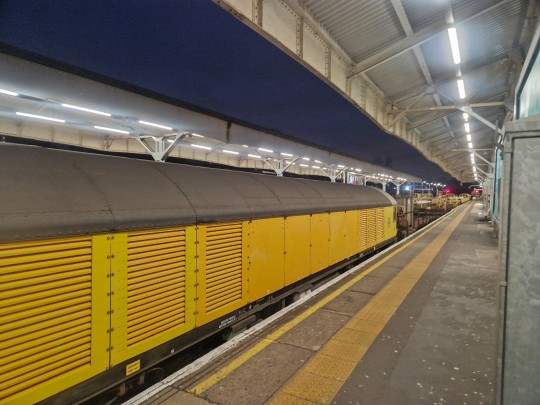
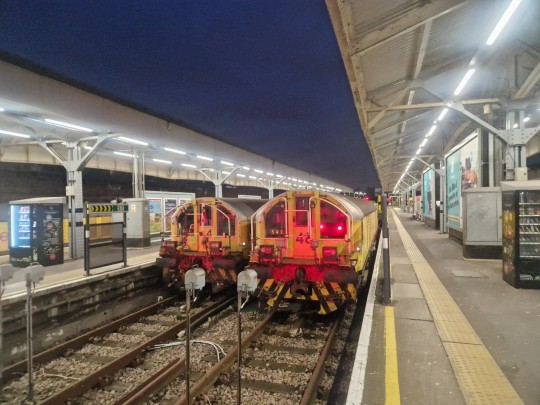
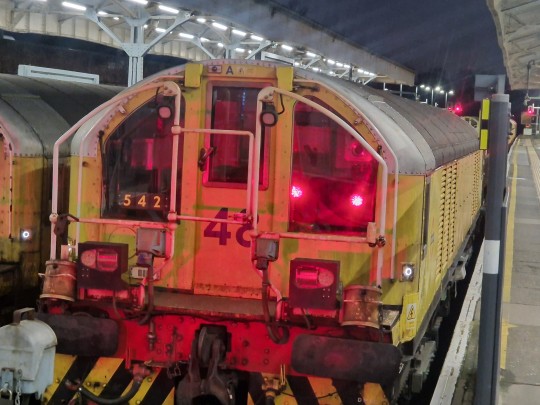

Some pictures of the trains at Wimbledon this evening...
L16 was manufactured in 1970/1 by Metro-Cammell (originally working on the Jubilee line construction), while L44 and L48 were built at Doncaster Works by British Rail Engineering Limited in 1973/74 (they originally worked in the construction of the Jubilee line and the Heathrow extension of the Piccadilly line).
These are @transportforlondon London Underground battery-electric locomotives L16, L44 and L48, battery locomotives used for hauling engineers' trains on the London Underground network where they can operate when the electric traction current is switched off.
0 notes
Text
Events 11.1 (after 1950)
1950 – Puerto Rican nationalists Griselio Torresola and Oscar Collazo attempt to assassinate US President Harry S. Truman at Blair House.
1951 – Operation Buster–Jangle: Six thousand five hundred United States Army soldiers are exposed to 'Desert Rock' atomic explosions for training purposes in Nevada. Participation is not voluntary.
1952 – Nuclear weapons testing: The United States successfully detonates Ivy Mike, the first thermonuclear device, at the Eniwetok atoll. The explosion had a yield of ten megatons TNT equivalent.
1954 – The Front de Libération Nationale fires the first shots of the Algerian War of Independence.
1955 – The establishment of a Military Assistance Advisory Group in South Vietnam marks the beginning of American involvement in the conflict.
1955 – The bombing of United Airlines Flight 629 occurs near Longmont, Colorado, killing all 39 passengers and five crew members aboard the Douglas DC-6B airliner.
1956 – The Indian states Kerala, Andhra Pradesh, and Mysore are formally created under the States Reorganisation Act; Kanyakumari district is joined to Tamil Nadu from Kerala.
1956 – Hungarian Revolution: Imre Nagy announces Hungary's neutrality and withdrawal from the Warsaw Pact. Soviet troops begin to re-enter Hungary, contrary to assurances by the Soviet government. János Kádár and Ferenc Münnich secretly defect to the Soviets.
1956 – The Springhill mining disaster in Springhill, Nova Scotia kills 39 miners; 88 are rescued.
1957 – The Mackinac Bridge, the world's longest suspension bridge between anchorages at the time, opens to traffic connecting Michigan's upper and lower peninsulas.
1963 – The Arecibo Observatory in Arecibo, Puerto Rico, with the largest radio telescope ever constructed, officially opens.
1963 – The 1963 South Vietnamese coup begins.
1968 – The Motion Picture Association of America's film rating system is officially introduced, originating with the ratings G, M, R, and X.
1970 – Club Cinq-Sept fire in Saint-Laurent-du-Pont, France kills 146 young people.
1973 – Watergate scandal: Leon Jaworski is appointed as the new Watergate Special Prosecutor.
1973 – The Indian state of Mysore is renamed as Karnataka to represent all the regions within Karunadu.
1979 – In Bolivia, Colonel Alberto Natusch executes a bloody coup d'état against the constitutional government of Wálter Guevara.
1979 – Griselda Álvarez becomes the first female governor of a state of Mexico.
1981 – Antigua and Barbuda gains independence from the United Kingdom.
1982 – Honda becomes the first Asian automobile company to produce cars in the United States with the opening of its factory in Marysville, Ohio; a Honda Accord is the first car produced there.
1984 – After the assassination of Indira Gandhi, Prime Minister of India on 31 October 1984, by two of her Sikh bodyguards, anti-Sikh riots erupt.
1987 – British Rail Class 43 (HST) hits the record speed of 238 km/h for rail vehicles with on-board fuel to generate electricity for traction motors.
1991 – President of the Chechen Republic Dzhokhar Dudayev declares sovereignty of the Chechen Republic of Ichkeria from the Russian Federation.
1993 – The Maastricht Treaty takes effect, formally establishing the European Union.
2000 – Chhattisgarh officially becomes the 26th state of India, formed from sixteen districts of eastern Madhya Pradesh.
2000 – Serbia and Montenegro joins the United Nations.
2001 – Turkey, Australia, and Canada agree to commit troops to the invasion of Afghanistan.
2011 – Mario Draghi succeeds Jean-Claude Trichet and becomes the third president of the European Central Bank.
2012 – A fuel tank truck crashes and explodes in the Saudi Arabian capital Riyadh, killing 26 people and injuring 135.
0 notes
Video
Inside Burton locomotive depot - c1964 by Frederick McLean
Via Flickr:
A photograph inside of British Railways (BR) Burton traction maintenance depot (17B?) showing part of the turntable, with two steam, and one diesel-electric locomotive in view. The steam numbers are hard to make out but I think they are, from left to right, Nos. 47643, 47250, and diesel-electric D5149. The photo is stuck in a old rail enthusiast album, unfortunately there is no date or photographer name, but they do appear to date from early/mid 1960s. ---------------------------------- No. 47643 was a H. Fowler designed class 3F, 0-6-0T engine, built by Beardmore, in Dalmuir, Glasgow and new to the London, Midland & Scottish Railway (LMS) in Jan 1929, carrying No. 16726, being renumbered to 7643 in 1934. In 1948 the railways were nationalised, becoming British Railways (BR), engine No. 7643 became No. 47643. The locomotive was withdrawn from service by BR in Oct 1966, then scrapped in June of the following year at 'Cashmore's Great Bridge' scrapyard. ---------------------------------- No. 47250 was a S. Johnson designed class 2441, 0-6-0T engine, built by the Vulcan Foundry and new to the Midland Railway (after grouping the London, Midland & Scottish Railway) in Jun 1902, carrying No. 2771, being renumbered to 1950 in 1907, then 7250 in 1934. In 1948 the railways were nationalised, becoming British Railways (BR), engine No. 7250 became No. 47250. The locomotive was withdrawn from service by BR in Jun 1965, then scrapped in the December. ---------------------------------- No. D5149 was a class 24, Bo-Bo wheeled diesel-electric locomotive, built by the Derby Works and new to BR in Feb 1961. It was withdrawn from service in Oct 1972, and in April of the following year was broken up at the Locomotive Works in St Rollox, Glasgow. ---------------------------------- If there are any errors in the above description please let me know. I know very little about locomotives! Thanks. 📷 Any photograph I post on Flickr is an original in my possession, nothing is ever copied/downloaded from another location. 📷 -------------------------------------------------
#Burton railway shed#Burton engine shed#Burton locomotive shed#engine shed#Burton upon Trent#Burton TMD#British Railways#British Rail#steam engine#steam locomotive#diesel electric#D5149#Class 24#Bo-Bo wheeled#Derby works#steam loco#old photograph#old transport#old locomotive#old steam engine#vintage transport#vintage photograph#locomotive#diesel electric locomotive#1960s#railway turntable#locomotive turntable#transport#transport history#transport photograph
0 notes
Text
Top 5 Electric Bikes in India with 200+ Kmph Range
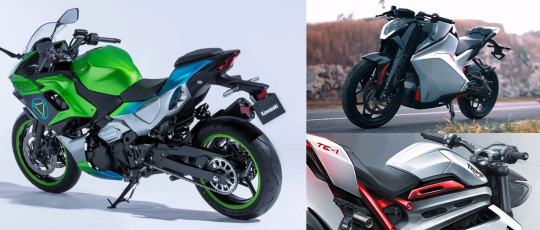
In recent years, the electric bike market in India has witnessed significant growth, fueled by the increasing demand for sustainable and efficient transportation options. As technology continues to advance, electric bikes in India are pushing the boundaries of performance, range, and speed. One crucial factor that riders consider when choosing an electric bike is its range – the distance it can travel on a single charge. With longer ranges, riders can confidently embark on extended journeys without worrying about running out of battery power.
Triumph TE-1
Claimed Range – 320 KM/CHARGE
The Triumph TE-1 represents a groundbreaking achievement in the realm of electric motorcycles, emerging as a remarkable product from the distinguished British motorcycle manufacturer. This exceptional bike is the result of a collaborative effort between Triumph, Williams Advanced Engineering, Integral Powertrain, and WMG at the University of Warwick. Demonstrating a fusion of state-of-the-art technology and visionary design, the TE-1 delivers an unparalleled riding experience.
Designed with rider comfort in mind, the TE-1 boasts a distinctive frame and suspension system that ensures a smooth and enjoyable ride. Crafted from lightweight aluminum, the frame, combined with a single-sided swing-arm suspension, facilitates effortless maneuverability and precise control. The bike’s regenerative braking system further enhances its efficiency, extending the battery’s lifespan. Additionally, the bike offers various connectivity options, including seamless integration with smartphones and built-in GPS navigation.
Ultraviolette F77
Claimed Range – 307 KM/CHARGE
The Ultraviolette F77 represents a remarkable achievement in the realm of electric motorcycles, developed and manufactured by Ultraviolette Automotive, a dynamic startup based in Bangalore. Serving as the company’s flagship offering, the F77 caters to performance-oriented riders seeking an electric alternative to conventional gasoline-powered sports bikes.
This powertrain exhibits a peak power output of 33.5 horsepower and also features fast charging capabilities, allowing the battery to reach 80% capacity in a mere 50 minutes.
The F77 boasts a lightweight trellis frame crafted from high-grade steel, striking a harmonious balance between strength and agility. Complementing its robust construction, the motorcycle incorporates top-quality components, including an inverted front fork, a rear monoshock, and dual-channel ABS, offering a sporty and responsive riding experience.
Kawasaki Ninja HEV
Estimated Claimed Range – 300 KM/CHARGE
Presenting the Kawasaki Ninja HEV, an extraordinary electric motorcycle that seamlessly merges dynamic sportiness with sustainable technology. With its sleek and aerodynamic design, this cutting-edge bike exudes a captivating allure while incorporating a powerful electric motor that delivers exhilarating acceleration. Furthermore, the Ninja HEV’s lightweight chassis enhances its agility and nimbleness on the open road.
Noteworthy features of the Kawasaki Ninja HEV encompass a state-of-the-art digital display panel that offers real-time information regarding crucial metrics such as speed and battery level. The motorcycle also boasts advanced safety features, including anti-lock brakes and traction control, ensuring riders can revel in a secure and comfortable ride at all times.
Srivaru Motors Prana
Claimed Range – 225 KM/CHARGE
With its sleek aesthetics and robust performance, Srivaru Motors Prana emerges as the preferred choice for environmentally conscious riders who value both style and performance.
A standout characteristic of the Srivaru Motors Prana lies in its lightweight construction that ensures ease of maneuverability, providing riders with a smooth and responsive experience on the road. Additionally, the Prana incorporates a host of advanced safety features, including disc brakes, LED headlights, and turn signals, thereby guaranteeing secure travel even in challenging conditions.
The Prana also impresses with its user-friendly interface. Equipped with a touchscreen display, the Srivaru Motors Prana furnishes real-time information on crucial metrics such as battery life, speed, and range. The intuitive interface caters to riders of all skill levels, enabling them to effortlessly operate the bike and revel in a seamless riding experience.
Evoke Urban Classic
Estimated Claimed Range – 200 KM/CHARGE
The Evoke Urban Classic represents a remarkable fusion of power, style, and functionality, offering an exceptional electric bike experience. Central to the Evoke Urban Classic’s performance lies a high-performance electric motor, capable of delivering an impressive 19 kW of power and 116 Nm of torque.
In terms of design, the Evoke Urban Classic artfully combines classic and modern elements, resulting in a retro-inspired aesthetic. Its low-slung frame, spacious and comfortable seat, and wide handlebar collectively contribute to a rider-friendly position. The bike also embraces advanced features, including a digital instrument cluster and a Bluetooth-enabled sound system, elevating the overall riding experience.
Further enhancing the Evoke Urban Classic’s appeal are its high-performance suspension system, dual-disc brakes, and advanced safety features such as ABS and traction control.
Conclusion
The electric bike market has seen remarkable progress in recent years, with a focus on extending the range of electric bikes in India to provide riders with longer and more versatile journeys.
The Triumph TE-1 showcases the collaboration between industry leaders, delivering an unparalleled riding experience with its innovative design and state-of-the-art features. The Ultraviolette F77, developed by a dynamic startup, offers performance-oriented riders a compelling electric alternative to traditional sports bikes.
The Kawasaki Ninja HEV impresses with its seamless integration of sportiness and sustainability, while the Srivaru Motors Prana stands out for its sleek aesthetics and user-friendly interface. The Evoke Urban Classic combines power, style, and functionality, providing an exceptional riding experience with its retro-inspired design.
As the electric bike market continues to evolve, we can expect even more impressive innovations and a wider range of options for riders seeking sustainable transportation. The future of electric biking is undoubtedly exciting, and these top 5 electric bikes in India are leading the charge toward a greener and more exhilarating future on the roads.
Explore more about these innovative electric vehicles on www.searchev.in and be a part of India's green mobility revolution.
0 notes
Text
Royal Enfield bike Showrooms in Chandigarh
Royal Enfield, simply is the best brand of bikes and KBSmotors is definitely place to buy one. Royal Enfield bike price starts from Rs. 1,45,072. Royal Enfield offers 6 new models in India with most popular bikes being Classic 350, Bullet 350 and Meteor 350. The upcoming bikes of Royal Enfield include Super Meteor 650 and Shotgun 650. Most expensive Royal Enfield bike is Continental GT 650, which is priced at Rs. 3,01,963.
Royal Enfield is one of the oldest surviving motorcycle manufacturers in the world. Established in 1901, the iconic British manufacturer started off by manufacturing motorcycles, bicycles, lawnmowers, stationary engines and more popularly, weapons. To this day, Royal Enfield continues to use the motto ‘Made like a gun’, in memory of its legacy. Royal Enfield bikes are known for the class they exude as much as for their signature thump. Royal Enfield was acquired by Eicher Motors in 1994, which proved to be a pivotal role in the resurgence of the manufacturer.
Long lasting Quality:
As per the members of RE fan club, these machines lasts longer than the 100 to 200 cc bikes due to its extremely good built-quality. "These can last up to 30 years easily, if maintained well".
Stability:
The bikes are heavier; these will provide unmatchable highway stability. This includes extreme windy and wet conditions. Additionally, even at 90kms/hr; you won't feel you are lightweight and are losing traction.
Easy to ride
The modern features like an electric starter, disc brakes have made it much easier to ride than the previous generation Royal Enfield bikes. Owning a Royal Enfield in earlier days required skills but not anymore. They have become much more conventional too. Earlier, the gear-lever was put on the right-hand side but now it has been shifted to the left-hand side, making it much easier to use. This also attracts a lot of buyers who stayed away from the brand.

Innovation
The Royal Enfield will become first Indian manufacturer to launch a parallel-twin cylinder motorcycle. That’s how they are advancing in the market. Later this year, the all-new 650cc parallel-twin engine powered Interceptor and the Continental GT will be launched. The bikes will be the most affordable twin-cylinder product in India, which will attract many more customers to the brand.
Diverse models
Royal Enfield has so far managed to hold its turf despite a line-up in which some models are outdated. They have established its foothold in the Indian market. Of late, the company has been making its presence felt on a global scale by setting up exclusive dealerships in Europe, Gulf and the US. The Royal Enfield portfolio currently comprises of the Bullet, Classic, Thunderbird, Himalayan, Interceptor 650 and Continental GT 650. Of these, the Bullet, Classic and Thunderbird are available in two versions powered by 350cc and 500cc engines.
Conclusion
Royal Enfield are fast, stable and diverse so if you’re attempting to buy Royal Enfield in Zirakpur, then you must visit Royal Enfield Chandigarh Showroom. Visit the KBS website to scour through their diverse collection of royal Enfield bikes.
1 note
·
View note
Text
Paints And Coatings Industry ESG - Thematic Report
Sustainable and innovative solutions, underpinned by ESG goals, have garnered immense traction in the paints and coatings industry. Substituting hazardous substances and minimizing energy demand have posed challenges to stakeholders. Needless to say, paints and coatings offer essential coatings for offshore wind power plants, add color to the spaces, boost durability and underpin the transportation and hygienic production of food. The substance has had a vital role in helping minimize the environmental footprint, largely due to its innate ability to boost recyclability and bolster the life cycle of several products.
Lately, key players have explored opportunities in waste management and efficient production processes. However, several companies in the paint industry have been accused of greenwashing—using sustainability as a marketing gimmick—to hide their environmental lapses. The UN chief has been vocal in pushing for zero tolerance for net-zero greenwashing. According to the competition regulator in the U.K. Competition and Markets Authority, 40% of green claims made online could be misleading.
The paints and coatings industry is one of the highly demanded markets; the products have high applicability across various ranging from automotive to infrastructure markets. EU’s corporate sustainability reporting directive (CSRD) will compel companies to disclose comprehensive data to enhance the assessment of their sustainability efforts. It is worth noting that the EU Council gave a nod to CSRD in November 2022, a buoyant step to curb divergent sustainability standards, propel the company’s accountability and ease the transition to a sustainable economy. In March 2022, the British Coatings Federation (BCF) rolled out the “Green Claims Guide to Decorative Paints” to tackle greenwash claims in decorative paints. BCF asserted that the use of the terms “VOC free” and “Zero VOC” are false claims and should be avoided in the paint industry.
The U.S. Federal Trade Commission initiated a set of Green Guides to help marketers ensure their claims are not deceptive. Prominently, Green Guides were first issued in the U.S. in the early 1990s. In December 2022, the FTC sought public comments—on the term “recyclable,” “recyclable content,” need for additional guidance and carbon offsets and climate change—on the likely updates to the Green Guides.
Leading companies that have propelled their ESG strategies are delineated below:
1. Sherwin-Williams Pits on Environmental Targets to Gain Ground
The environmental profile has garnered prominence as sustainability continues to steer the growth across business verticals. Companies are pushing to the limit and finding ESG as a pivotal portfolio to contain carbon emissions and reduce waste in their value chain. Sherwin-Williams laid down its 2030 environmental footprint targets—to minimize waste disposal intensity by 25%, curb absolute Scope 1 and 2 greenhouse gas emissions by 30%, boost operational energy efficiency by 20% and expedite electricity from renewable sources to 50% of total electricity usage. The company notes that failure to mitigate environmental impact and emissions or respond to shifting consumer behavior and preferences could have repercussions in the form of reduced demand for products and services.
2. AkzoNobel Propels Carbon Neutrality Commitment
Companies, such as AkzoNobel have recognized the significance of ESG and underpinned their sustainability quotient. The Netherlands-based company committed to becoming carbon neutral by 2050 and has used a holistic Sustainable Product Portfolio Assessment (SPPA) framework. The chemicals firm is on course to becoming a zero waste company by 2030—77% reduction in waste to landfill was witnessed in 2021 vis-à-vis the preceding year. It has also developed wood coatings to foster manufacturing efficiency and energy-saving powder coating to provide 30% more output.
Is your business one of participants to the Global Paints and Coatings Industry? Contact us for focused consultation around ESG Investing, and help you build sustainable business practices.
3. PPG Industries Banks on Diversity, Equity and Inclusion to Stay Ahead of the Curve
Paints and coatings manufacturers have exhibited an unwavering commitment to further a culture of diversity, equity and inclusion. Chemical companies are leaving to stone unturned to propel the leadership roles for women and under-represented ethnic or racial groups. Not to mention, leading players have furthered their investments in bullish initiatives to strengthen accountability and engagement. In essence, PPG mentioned in its 2021 ESG report that an infusion of USD 7.4 million was made to underscore racial equity with educational pathways for people of color and black communities. It also injected USD 13 million to foster education and community sustainability in communities globally, while it is also committed to pouring USD 20 million from 2020 through 2025 to boost educational opportunities and social justice in underrepresented communities.
4. Nippon Paint Holdings Emphasizes Occupational Health & Safety
Global watchdogs have pushed for increased health measures as chemicals manufacturing is prone to accidents and health hazards. Investments in workplace safety have become pronounced to undergird the social profile. In 2022, Nippon Paint embraced the Group-wide Global Code of Conduct that considered stakeholder and employee safety in its activities. Meanwhile, in FY 2020, the Japanese behemoth updated the risk assessment lists to identify and address serious risks, including explosions and fire that lead to operation suspension. It has also put the spotlight on safety training programs. The company offered an online ISO internal auditor training course to 113 participants, online follow-up training to 78 new employees and online entry training to 89 new employees.
5. BASF Navigates Opportunities in Corporate Governance
Transparent and effective corporate governance has become indispensable to supervising and managing organizations and enthusing the confidence of financial markets, investors, employees, customers and other stakeholders. BASF has a two-tier corporate governance system with an effective and transparent separation of company supervision and management between its Board of Executive Directors and the Supervisory Board. As of December 2021, the German multinational company had six members on the Board of Executive Directors. It has also taken a giant stride in compliance management, emphasizing audits and participation in training. In the 2021 report, BASF inferred that 77 internal audits were conducted on adherence to compliance standards and over 53,000 employees participated in compliance training.
6. RPM Prioritizes Diversity in Board Vacancies
Concerted efforts from RPM towards corporate governance and ethical practices & programs have placed the company in a solid position. It has deployed Route 168 training program and promoted transparency, balanced decision-making and diversity & inclusion across its operations. The Governance and Nominating Committee of RPM reports to the full Board on developing and recommending a set of corporate governance principles, overseeing ESG strategy, and identifying diverse candidates for Board members, among others. In January 2020, the company gave a green light to the Rooney Rule to fill Board vacancies, suggesting a mandate to include diversity in ethnicity and gender in the selection pool.
Companies of all sizes have envisaged ESG as tailwinds that can open avenues of growth and innovations. Leading players are gearing to underpin effective governance frameworks for fairness of the management, objectivity and transparency, and most importantly—to earn trust. A sustainable solution, waste management and a renewed focus on health & safety are some of the underlying factors that can take the ESG goals to a whole new level. The paints and coatings market size was pegged at USD 146.17 billion in 2019 and could witness a 4.3% CAGR between 2020 and 2027. Bullish ESG strategies will be pivotal to tapping into the global landscape.
About Astra – ESG Solutions By Grand View Research
Astra is the Environmental, Social, and Governance (ESG) arm of Grand View Research Inc. – a global market research publishing & management consulting firm.
Astra offers comprehensive ESG thematic assessment & scores across diverse impact & socially responsible investment topics, including both public and private companies along with intuitive dashboards. Our ESG solutions are powered by robust fundamental & alternative information. Astra specializes in consulting services that equip corporates and the investment community with the in-depth ESG research and actionable insight they need to support their bottom lines and their values. We have supported our clients across diverse ESG consulting projects & advisory services, including climate strategies & assessment, ESG benchmarking, stakeholder engagement programs, active ownership, developing ESG investment strategies, ESG data services, build corporate sustainability reports. Astra team includes a pool of industry experts and ESG enthusiasts who possess extensive end-end ESG research and consulting experience at a global level.
For more ESG Thematic reports, please visit Astra ESG Solutions, powered by Grand View Research
0 notes
Photo

Here is the first in a series of concept art for the first episode of Tale from the Tarmingham Overhead of the one of the scenes that'll be featured in the episode.
It is January of 1970 and having arrived yesterday from their home in Devon on a five year loan to the Overhead in the city of Tarmingham to help out with the motive power shortage on the railway. Danwood and Sanworth the Class 101 DMU's are soon to be recoupled together ready for a trial run along the Walaceton Line to Walaceton in Suffolk, to see if they would perform well on that service to allow Gareth to be moved on to another service and other duties on the railway.
While they were being prepared the other engines left to start their work, while the last engine to leave the shed who was a regular guest to the engines of the Overhead, was a Class 37 called Andrew who usually worked the top expresses out of Tarmingham down to London Liverpool Street on the Great Eastern Mainline, along with stopping services between there and Norwich. He was heading out to take an express down to London, when he began brooding to himself about something. Danwood having noticed this asked Andrew if he was alright. Andrew told him rudely that it was none of his business and lied to him that he was fine, to which Danwood didn't take lightly to and told Andrew that he wasn't going to fall for a lie that he used to cover up what was on his mind.
Knowing that he wasn't going to hide his thoughts with a lie to one of the engines who worked for the same operator as him. Andrew give in as soon as the turntable stopped moving. In a grouchy tone, he told him and Sanworth that after what the other engines told them about the current state of the Overhead and how they believed that the railway was probably in it's final day's of existence. He stated that life was not simple or an idealist utopia that their kind was led to believe in the first place, and believed that BR and the humans in charge, had failed to prevent the discrimination brought upon them by their steam breathing predecessors and that their modernisation plan had been nothing but a costly failure, that was only done for the sack of the government tax payers to continue running BR into the ground, and that Alistair was no different to BR's management. Seeing as he was once a CEO of an American road construction firm, which was so happened to be working with him and through manipulation sent the Overhead into the state it found itself in for fourteen years.
Andrew started by expressing his distrust for steam engines, as he believed that they brought discrimination against him and other diesels because they feared them and let their belief that steam traction was still superior than diesel power blind them to the point of extremism and near oppression of their kind. Which was a huge shocker for Danwood and Sanworth having worked with a steam engine themselves on their branch line back home before he was withdrawn and scrapped, and wasn't like the ones Andrew had described. Andrew told them that he was one of the few who didn't side with his prejudice peers, seeing those who were like him as the only ones whoever seemed to got along with diesels. Despite this he believed it still didn't justify their peers actions that were brought against them and they did nothing to prevent their suffering.
This hate was made even more so by the organisation who fought for steam to remain the dominate motive power on the railways, the British Steam Locomotive Liberation Front, who under the leadership a manipulative human being lead a futile campaign in an attempt to prevent diesel's and electrics from replacing steam locomotives in their entirety in favour of some unachievable aim to have steam turbine engines be the next phase of locomotive traction. Through strike action outside stations and small damaging accidents that disrupted the system, they committed to more discriminatory actions towards their successors to that of hate crimes committed towards people of colour.
This treatment by steam engines eventually reached a boiling point where the Liberation abandoned their role of fighting for the rights of steam locomotives and the members including several engines turned into steam power extremists hell-bent on resorting to violent acts in an attempt to destroy their species to extinction and to force BR into ending the dieselisation program. Andrew then said that the steam locomotives and their terror group eventually got their comeuppance by the end of their time on the railways two years back, when those who were members were finally arrested for their crimes. But because of the abuse that he experienced during that period with some engines and because of what they did, Andrew treated all steam locomotives with deep distrust and suspicion, and was lead to cynicism that they only cared about themselves than the lives of other motive power round them, and that view would probably never change for him.
He took this further in his next point, and that they were also responsible for the death of his favourite sister Olivia. Who was brutally murdered along with some other engines in a horrific shed explosion in 1965 at the hands of the liberation parking fuel tankers in the shed and setting them alight. He was of course there at the time outside the shed and he had to watch in horror and helplessness as he tearfully watched his sister burn to death right before his very eyes. Even to that day Andrew could still see that gruesome image flying around in his mind of his sisters death, and it was a scar he believed would never heal. Therefore he blamed the steam engines involved in the incident and the liberation for taking Olivia away from him, and he also stated that he also blamed BR for doing nothing to prevent her and the other diesels from being burned to death at the hands of them. Feeling his loss Danwood and Sanworth could only symphysis with him, but said nothing as Andrew continued. He also felt that other diesels who had lost siblings to the liberation had also been let down by BR and had to deal with years of loss a deep never-ending one.
Finally Andrew brought up the leader of the Diesel and Electric locomotives and the assistant to BR's management himself, Lord Edward. Who Andrew saw as an ideological, capitalistic, patronising and deceitful liar who only cared about fulling their kinds minds with nothing but lies about how BR's modernisation was a success and that dieselisation was the way of the future. When he failed to see that BR was not this private company that run for the sack of improving services through profit, and was instead a government funded enterprise that rallied on tax payer money from the public in order to survive. Something that he believed the government had been downplaying for years, as Lord Edward was actually running the services and the modernisation program into the ground to where Andrew saw it as a massive failure, as the network was now in a trouble state outside the mainline and London routes as most of the rural lines had simply been left to rot with most of their services having been cut and the trains were running late, tracks deteriorated, and rolling stock being old and outdated. To where the public saw the system as being more of a joke now, than one that Lord Edward could show off in that stuck up brain of lies of his.
Andrew then went onto what he considered the worse thing about Lord Edward, his constant lies towards diesels that they were the future of locomotive traction on the railways. Which he blamed for further incinerating the violence brought upon them by the steam engines and the liberation. As it was the enforcement of this belief that lead to his followers and other diesels to be aggressive towards steam locomotives that lead them to have massive resentment towards them. Andrew told the two DMU's that he saw it as propaganda to create unrest and ingrain supremacist views towards steam engines into their minds without considering the fact that maybe one day they too would be seen as obsolete as their predecessors, due to him having seen diesels of failed designs being scrapped, which helped him realise that in truth they weren't superior as Lord Edward had lead most to believe. Andrew also saw with his own eyes that as Edwards followers continued to believe his lies and show supremacy towards steam locomotives, their discontent with them continued to rise, to when the liberation would eventually turn to extremism and commit many of the acts that he mentioned earlier. Many who had come to fear them thought that Lord Edward and BR themselves would be their saviours who would protect them from the threats of the liberation.
However even that was a lie that he could see, as what did Lord Edward do when the threat arise. Andrew told Danwood and Sanworth that Lord Edward and BR did absolutely nothing to prevent further suffering of those he was meant to represent, as he and the management spent most of that time focusing on their pointless modernisation plan and Edward focusing mostly on making BR profitable, increasing dieselisation and reducing services despite the safety of passengers, stuff and engines being at risk from the liberations threats being aimed at him and BR. Proving that Lord Edward was an engine who didn't care about the safety of others around him when it came to crimes being committed by the liberation, and was lying to make himself look good in front of his followers so that they wouldn't acknowledge what was happening behind their cabs. While BR eventually did realise the situation in the end and got the British Transport Police involved in the end to take the liberation down. The loss of innocent lives and the discrimination from steam engines though Lord Edwards incompetence of not being there for his fellow diesels including Olivia to Andrew was unforgivable and BR was no better as far as he was concerned. He told Danwood and Sanworth that since then he showed a strong resentment towards Lord Edward and the displeasure of working under a publicly run railway system who couldn't careless about modernising and improving standards, showing safety to their engines in times of crisis and were responsible for the downfall the entire British Railway network in not only his eyes, but also the publics eyes who saw them as being a no good unreliable service to the British people.
After expressing his long discontent with the state of BR, the abuse he received from the steam engines, his loss and distrust of them and Lord Edward to Danwood and Sanworth in his harsh terms. Andrew told the two that even the Overhead wouldn't survive for much longer and that their time on it would probably be short lived, as Mr Ruleton himself was hopeless of the situation his railway was in with Alistair in charge as mayor, and that it would be Alistair's fault for why the railway fell. If even they somehow manage to vote him out, the railway would never be able to bounce back from it's financial crisis and would be forced into receivership, as the damage would've already have been done. Him finally saying "No publicly owned railway is ever the best." before heading off to take his train, little knowing the two DMU brothers would soon prove him wrong about the Overheads survival.
Danwood, Sanworth, Andrew, Tarmingham Overhead and other characters © Great Eastern J69
#Livingmachine#Livingmachines#Livinglocomotive#Livinglocomotives#BR#BritishRail#Class101#Class37#TOH#Tarmingham Overhead Railway
0 notes
